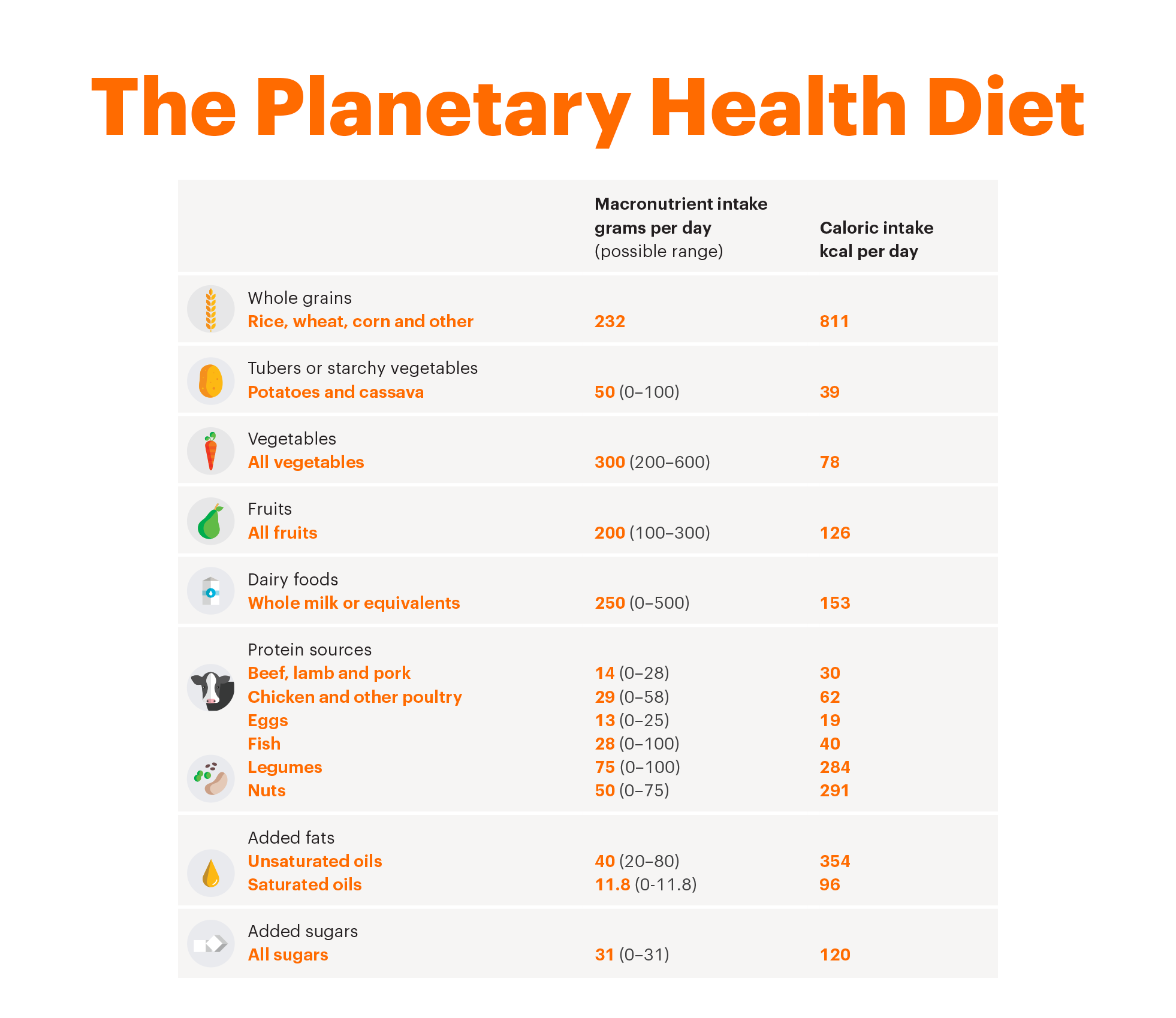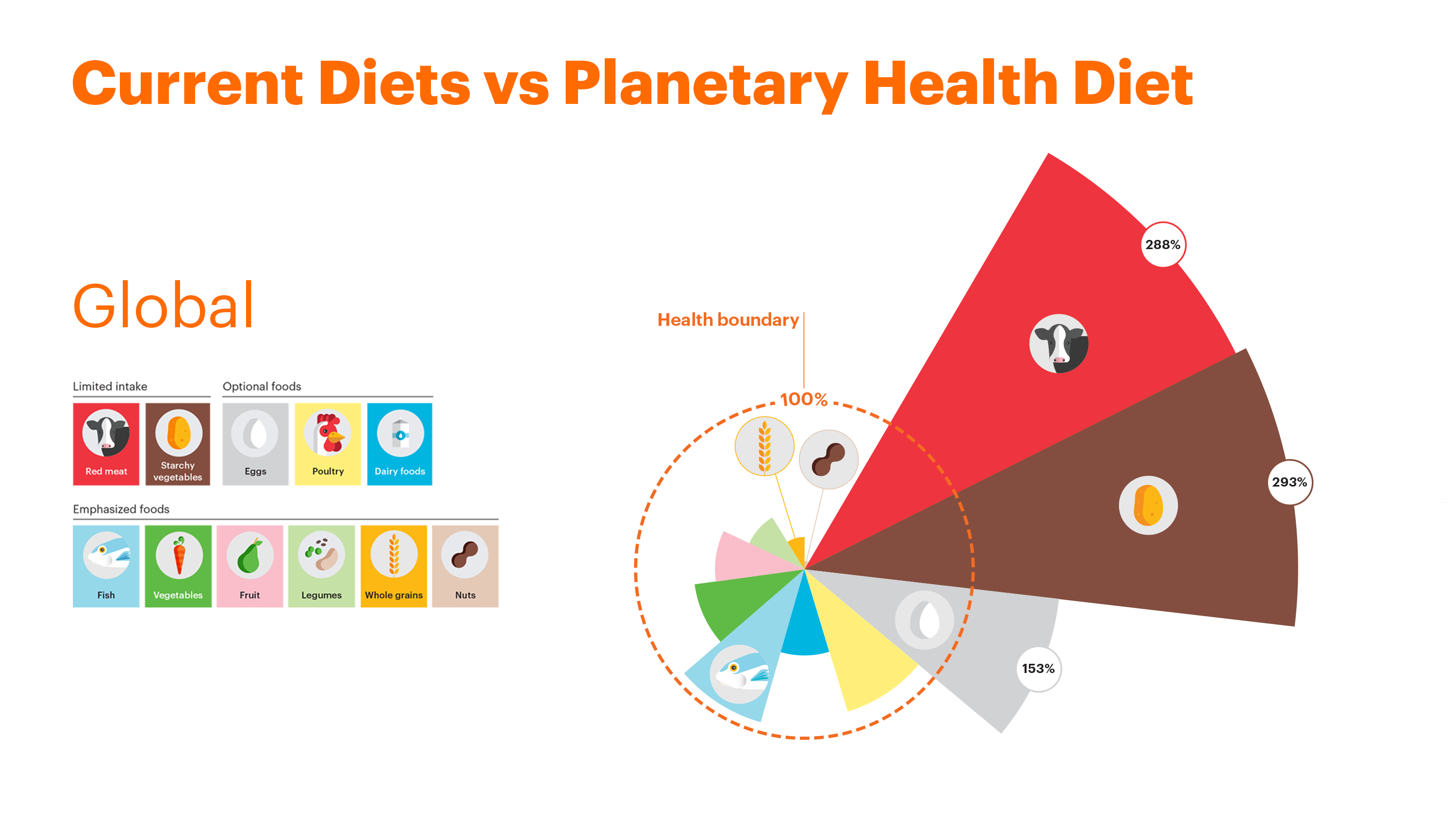 With more than 3 billion people malnourished and food production driving climate change, biodiversity loss and pollution, a transformation of the global food system is urgently needed.
With more than 3 billion people malnourished and food production driving climate change, biodiversity loss and pollution, a transformation of the global food system is urgently needed.
Findings from the EAT-Lancet Commission on Healthy Diets From Sustainable Food Systems provides the first scientific targets for a healthy diet from a sustainable food production system that operates within planetary boundaries for food. The report promotes diets consisting of a variety of plant-based foods, with low amounts of animal-based foods, refined grains, highly processed foods, and added sugars, and with unsaturated rather than saturated fats.
The work behind the report is the result of a collaboration between 37 experts from 16 countries with expertise in health, nutrition, environmental sustainability, food systems, economics and political governance. Stockholm Resilience Centre was the scientific coordinator of the report.
Getting it Seriously Wrong
Human diets inextricably link health and environmental sustainability, and have the potential to nurture both. However, current diets are pushing the Earth beyond its planetary boundaries, while causing ill health. This puts both people and the planet at risk. Providing healthy diets from sustainable food systems is an immediate challenge as the population continues to grow – projected to reach 10 billion people by 2050 – and get wealthier (with the expectation of higher consumption of animal-based foods).
To meet this challenge, dietary changes must be combined with improved food production and reduced food waste. The authors stress that unprecedented global collaboration and commitment will be needed, alongside immediate changes such as refocussing agriculture to produce varied nutrient-rich crops, and increased governance of land and ocean use.
“The food we eat and how we produce it determines the health of people and the planet, and we are currently getting this seriously wrong.” Tim Lang, commission co-author, City, University of London, UK
Scientific Targets for a Healthy Diet
Despite increased food production contributing to improved life expectancy and reductions in hunger, infant and child mortality rates, and global poverty over the past 50 years, these benefits are now being offset by global shifts towards unhealthy diets high in calories, sugar, refined starches and animal-based foods and low in fruits, vegetables, whole grains, legumes, nuts and seeds, and fish.
The authors argue that the lack of scientific targets for a healthy diet have hindered efforts to transform the food system. Based on the best available evidence, the commission proposes a dietary pattern that meets nutritional requirements, promotes health, and allows the world to stay within planetary boundaries.
Compared with current diets, global adoption of the new recommendations by 2050 will require global consumption of foods such as red meat and sugar to decrease by more than 50%, while consumption of nuts, fruits, vegetables, and legumes must increase more than two-fold. Global targets will need to be applied locally – for example, countries in North America eat almost 6.5 times the recommended amount of red meat, while countries in South Asia eat only half the recommended amount. All countries are eating more starchy vegetables (potatoes and cassava) than recommended with intakes ranging from between 1.5 times above the recommendation in South Asia and by 7.5 times in sub-Saharan Africa.
“To be healthy, diets must have an appropriate calorie intake and consist of a variety of plant-based foods, low amounts of animal-based foods, unsaturated rather than saturated fats, and few refined grains, highly processed foods, and added sugars. The food group intake ranges that we suggest allow flexibility to accommodate various food types, agricultural systems, cultural traditions, and individual dietary preferences – including numerous omnivore, vegetarian, and vegan diets,” says co-lead commissioner Walter Willett from Harvard University.
 The authors estimate that widespread adoption of such a diet would improve intakes of most nutrients. They also modelled the potential effects of global adoption of the diet on deaths from diet-related diseases. Three models each showed major health benefits, suggesting that adopting the new diet globally could avert between 10.9-11.6 million premature deaths per year – reducing adult deaths by between 19-23.6%.
The authors estimate that widespread adoption of such a diet would improve intakes of most nutrients. They also modelled the potential effects of global adoption of the diet on deaths from diet-related diseases. Three models each showed major health benefits, suggesting that adopting the new diet globally could avert between 10.9-11.6 million premature deaths per year – reducing adult deaths by between 19-23.6%.
Food Sustainability
Since the mid-1950s, the pace and scale of environmental change has grown exponentially. Food production is the largest source of environmental degradation. To be sustainable, food production must occur within food-related planetary boundaries for climate change, biodiversity loss, land and water use, as well as for nitrogen and phosphorus cycles. However, production must also be sustainably intensified to meet the global population’s growing food demands.
”The shift towards sustainable food production will require decarbonising agricultural production by eliminating the use of fossil fuels and turn land use into a net carbon sink. In addition, we need to safeguard existing biodiversity, have no net expansion of cropland, and develop drastic improvements in fertiliser and water use efficiencies,” says commission co-author Line Gordon, director of the Stockholm Resilience Centre.
The authors estimate the minimum, unavoidable emissions of greenhouse gases if we are to provide healthy food for 10 billion people by 2050. They conclude that non-CO2 greenhouse gas emissions of methane and nitrous oxide will remain between 4.7-5.4 gigatonnes in 2050, with current emissions already at an estimated 5.2 gigatonnes in 2010. This suggests that the decarbonisation of the world energy system must progress faster than anticipated, to accommodate the need to healthily feed humans without further damaging the planet.
Phosphorus use must also be reduced (from 17.9 to between 6-16 teragrams), as must biodiversity loss (from 100 to between 1-80 extinctions per million species each year).
Based on their estimates, current levels of nitrogen, land and water use may be within the projected 2050 boundary (from 131.8 teragrams in 2010 to between 65-140 in 2050, from 12.6 M km2 in 2010 vs 11-15 M km2 in 2050, and from 1.8 M km3 in 2010 vs 1-4 M km3, respectively) but will require continued efforts to sustain this level. The boundary estimates are subject to uncertainty, and will require continuous update and refinement.
Using these boundary targets, the authors modelled various scenarios to develop a sustainable food system and deliver healthy diets by 2050. To stay within planetary boundaries, a combination of major dietary change, improved food production through enhanced agriculture and technology changes, and reduced food waste during production and at the point of consumption will be needed, and no single measure is enough to stay within all of the limits.
“There is no silver bullet for combatting harmful food production practices, but by defining and quantifying a safe operating space for food systems, diets can be identified that will nurture human health and support environmental sustainability.” Johan Rockström, co-lead commissioner, Stockholm Resilience Centre and the Potsdam Institute for Climate Impact Research
Five Strategies for Change
The commission proposes five strategies to adjust what people eat and how it is produced:
1. Encourage people to choose healthier diets by improving availability and accessibility to healthy food. As this may increase costs to consumers, social protection for vulnerable groups may be required to avoid continued poor nutrition in low-income groups
2. Refocus agriculture from producing high volumes of crops to producing varied nutrient-rich ones. Global agriculture policies should incentivise producers to grow nutritious, plant-based foods, develop programmes that support diverse production systems, and increase research funding for ways to increase nutrition and sustainability
3. Sustainably intensify agriculture while taking into account local conditions to help apply appropriate agricultural practices and generate sustainable, high quality crops
4. Preserve natural ecosystems and ensure continued food supplies. This could be achieved through protecting intact natural areas on land (potentially through incentives), prohibiting land clearing, restoring degraded land, removing harmful fishing subsidies, and closing at least 10% of marine areas to fishing (including the high seas to create fish banks). “In fact, improved capture fisheries governance and reduced aquaculture footprints will be key in determining whether we succeed in maintaining seafood as a component of a healthy diet in the future”, says Beatrice Crona, report co-author, centre researcher and executive director of the GEDB programme at the Royal Swedish Academy of Sciences.
5. Half food waste. The majority of food waste occurs in low- and middle-income countries during food production due to poor harvest planning, lack of access to markets preventing produce from being sold, and lack of infrastructure to store and process foods. Improved investment in technology and education for farmers is needed. But food waste is also an issue in high-income countries, where it is primarily caused by consumers. This can be resolved through campaigns to improve shopping habits, help understand ‘best before’ and ‘use by’ dates, and improve food storage, preparation, portion sizes and use of leftovers.
Richard Horton, editor-in-chief at The Lancet, concludes:
“The transformation that the commission calls for is not superficial or simple, and requires a focus on complex systems, incentives, and regulations, with communities and governments at multiple levels having a part to play in redefining how we eat. Our connection with nature holds the answer, and if we can eat in a way that works for our planet as well as our bodies, the natural balance of the planet’s resources will be restored.”












